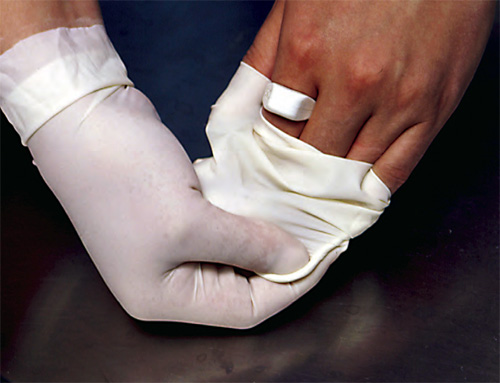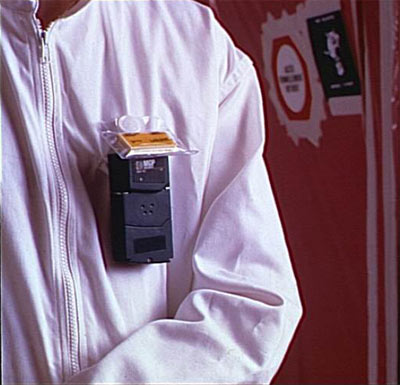Measuring radioactive doses
Dosimetry is the measurement of ionizing radiation in a given place or on a person (which is called individual dosimetry). As a radioprotection tool, its purpose is to provide an estimate of quantities such as the equivalent dose or the effective dose resulting from exposure during a certain amount of time.

Dosimetry in nuclear medicine
Thermoluminescent ring used for the radioprotection of the staff of a Nuclear Medicine Service handling radioactive substances with gloves. These dosimeters measure the doses at fingertips.
© ASN
The wide variety of situations and radiation leads to a great diversity of cases where dosimetry comes into play. Radiation is distinguished by photon, beta, neutron and possibly alpha dosimetry. Then, for a living organism, one has to distinguish between the sources of radiation, the internal dosimetry (the source is in the body) from the external dosimetry (the source is outside the body).
If the radiation source is internal, the dose measurement is difficult. It can be done indirectly (by the analysis of stools, urine …), or by direct measurement (anthroporadiametry), or in medical applications by in-vivo dosimetry systems.
If the radiation is only external (irradiation), which is the most frequent case, dosimetry uses detectors called dosimeters. The regulation imposes dosimeters that must be worn on the chest by workers likely to be exposed to ionizing radiation. Measuring the cumulative dose over a period of one to a few months, they are said to be passive. Passive dosimeters make it possible to track their exposure over time.
In parallel, when it comes to monitoring a workplace, room dosimeters can be implemented in a fixed position.
Accordingly to the french radioprotection rules, workers identified as being exposed to ionizing radiation must wear a whole-body passive dosimetry. In addition to these whole-body dosimeters, specific passive dosimeters can be worn when parts of the body may be more exposed. It concerns the fingers (for example, in surgery or in the nuclear industry when working in a glove box. ) or the eye lens (for example, in surgery).
Individual dosimetry allows radiological monitoring (verification that the doses received are within the regulatory limits), but it must also provide the fast maximum information in case of accidental irradiations and if possible serve as an alarm in these situations. To deal with these, concerned workers also have operational dosimetry with direct reading and alarms. For this purpose, active dosimeters will be used to measure dose rates, instantaneous radiation.
The variety of situations and radiation has led to a great diversity of dosimeters, which must also regularly adapt to changes in regulatory limits (it is sometimes even their improvements that allow to define new limits).

Dose monitoring
Individuals who are frequently exposed to radioactivity, either by working in the nuclear industry or elsewhere, regularly wear dosimeters to measure and control the doses absorbed. This worker from the Brennilis demolition plant wears an electronic dosimeter in addition to the legally required strip of dosimetric film. The advantage of the electronic device is that it allows him to check the instantaneous dose absorbed at any given time, as opposed to the average value indicated by the film.
© CEA-GONIN
Individual dosimetry should, ideally, fulfil a wide range of tasks. Apart from providing permanent surveillance (to ensure that the absorbed dose does not surpass the legal maximum), it should also say more about the type of radiation, the nature of the risks, and serve as an automatic alarm.
Individual dosimetry has long been provided by photographic dosimeters, dosifilms,or film-badges. Not enough sensitive, they are replaced today by OSL, radiophotoluminescent or thermoluminescent dosimeters.
Finally, dosimeters should be able to operate in a wide variety of environments (temperature, humidity, orientation, etc.), which may affect their accuracy. In many cases, the robustness will be more important than accuracy : better a dose estimate, even approximate, than no estimate !
Thanks to advances in detection techniques and the possibilities offered by digital techniques, dosimetry is evolving and has improved.
The radiation protection of personnel exposed to the risks caused by ionizing radiation is subject to strict regulations in a country like France. This regulation, which is changing with time, requires a follow-up of the doses received, in particular thanks to dosimeters worn on the chest by workers likely to be exposed to these radiations. The results are sent to radiation protection advisers as well as to the doctors in charge of the concerned employees.
IRSN access (in french)
Articles on the subject « Dosimetry »
Passive Dosimeters
Portable dosimeters for monitoring of exposed people Dosimeters called passive are dosimeters tha[...]
OSL Dosimeters
Dosimetry by « Optically stimulated luminescence » The active element of an OSL detector i[...]
RPL Dosimeters
Sensitive, robust and widely used dosimeters These passive dosimeters use radiophotoluminescence [...]
TLD Dosimeters
Exploit thermoluminescence for dosimetry The energy provided by ionizing radiation may cause defe[...]
Active Dosimeters
For real-time monitoring of workers exposed to radiation Active dosimeters are in fact ele[...]